After learning about the legacy of Mexican artist Frida Kahlo and her famous self portraits, students will draw a playful and colorful variation of a Kahlo portrait using oil pastels. Recommended for 3rd Graders.
Color: the visible range of reflected light. The 3 primary colors are red, blue and yellow. They can be mixed to make the 3 secondary colors of green, orange and violet.
Line: an element of visual arts; the flat path of a dot through space used by artists to control the viewer’s eye movement; a long narrow mark or stroke made on or in a surface; a thin mark made by a pencil, pen, or brush.
Shape: a two-dimensional (flat) area enclosed by a line: geometric: shapes and/or forms that are based on mathematical principles, such as a square/cube, circle/sphere, triangle/cone, or pyramid. organic: shapes and/or forms that are irregular, often curving or rounded, and more informal than geometric shapes.
Space: the area within an artwork; the illusion of depth creates 3-d space on a 2-d surface by means of rendering shapes’ sizes to overlap and using linear perspective.
Balance: A way of combining elements to add a feeling of equilibrium to a work of art. Major types are symmetrical and asymmetrical. This lesson will focus on symmetrical, in which elements are repeated on both sides of an imaginary vertical line bisecting the space in a ‘mirror’ image.
Pattern: element(s) repeated in a regular arrangement. In this lesson lines, shapes and colors are repeated
Blending colors is a term used often in art, particularly in painting and drawing. It is the technique of gently intermingling two or more colors or values to create a gradual transition or new color, or to soften lines.
Contour lines are used to define edges. They create boundaries around or inside an object.
• Oil Pastels
Frida Kahlo (1907-1954) was German-Mexican, raised in a small Mexican village, disabled with polio as a child. Her father was a prominent photographer and he taught her how to use the camera and let her paint portraits, fruits and animals. At age 18 she was in a bus accident and lived with back problems for the rest of her life. She painted constantly: in bed or in a wheelchair. She painted everything she could reach: self-portraits, her jewelry and dresses, even her pets (a deer, monkey, birds and a dog). She was inspired by Mexican folk culture and her Catholic beliefs. This helped her cope with having to stay immobile for so long.
At age 21, she married Mexican Diego Rivera, a famous muralist that painted everyday Mexican people on the street. The couple’s art became very popular in Europe and America. She painted for the rest of her short life, despite all her health issues.
If there is time to read a book to the class, thes are recommended: “Frida” by Jonah Winter, “Viva Frida” by Yuyi Morales, “Who was Frida?” by Sarah Fabiny.
Students will:
This lesson starts as a “guided” drawing. First, you demonstrate a step, next, have your students do it, then demonstrate the next step.
.png)
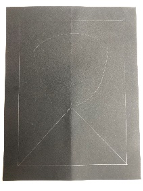
.png)
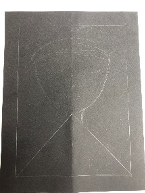
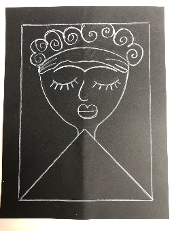
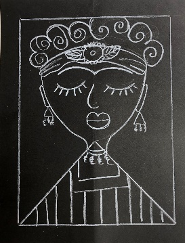
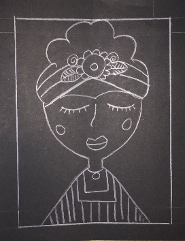
Lesson written by Amaranta Sandys.
Books: “Frida” by Jonah Winter, “Viva Frida” by Yuyi Morales, “Who was Frida?” by Sarah Fabiny.
21st Century Thinking Skills
Observing, making connections, visualizing, sequencing, comparing/contrasting, finding evidence, problem solving, determining point of view, decision making, evaluating.
WA State Learning Standards
(VA:Cr2.1.3) a. Create personally satisfying artwork, using a variety of artistic processes and materials.
(VA:Cr2.2.3) a. Demonstrate an understanding of the safe and proficient use of materials, tools, and equipment for a variety of artistic processes.
(VA:Cr3.1.3) a. Elaborate visual information by adding details in an artwork to enhance emerging meaning.
(VA:Pr6.1.3) a. Identify and explain how and where different cultures record and illustrate stories and history of life through art.
(VA:Re7.1.3) a. Speculate about processes an artist uses to create a work of art. This happens when seeing the connection between an artist’s life experiences and the art they make.
(VA:Re7.2.3) a. Determine messages communicated by an image.
(VA:Re8.1.3) a. Interpret art by analyzing use of media to create subject matter, characteristics of form, and mood.
(VA:Re9.1.3) a. Evaluate an artwork based on given criteria. This happens when looking for evidence of following directions.
(VA:Cn10.1.3) a. Develop a work of art based on observations of surroundings.
(VA:Cn11.1.3) a. Recognize that responses to art change depending on knowledge of the time and place in which it was made.
Arts Integration Opportunities
Writing: creative writing about one of Kahlo’s paintings; procedural writing about the steps followed to make the portrait; biography of Kahlo’s life.
Please note: These lesson plans are intended for non-profit use only. Use of these plans for commercial purposes should give attribution to the Issaquah Schools Foundation and be accompanied by a nominal donation at www.isfdn.org/donate. Thank you.
Fueling Success for Every Student, Every School